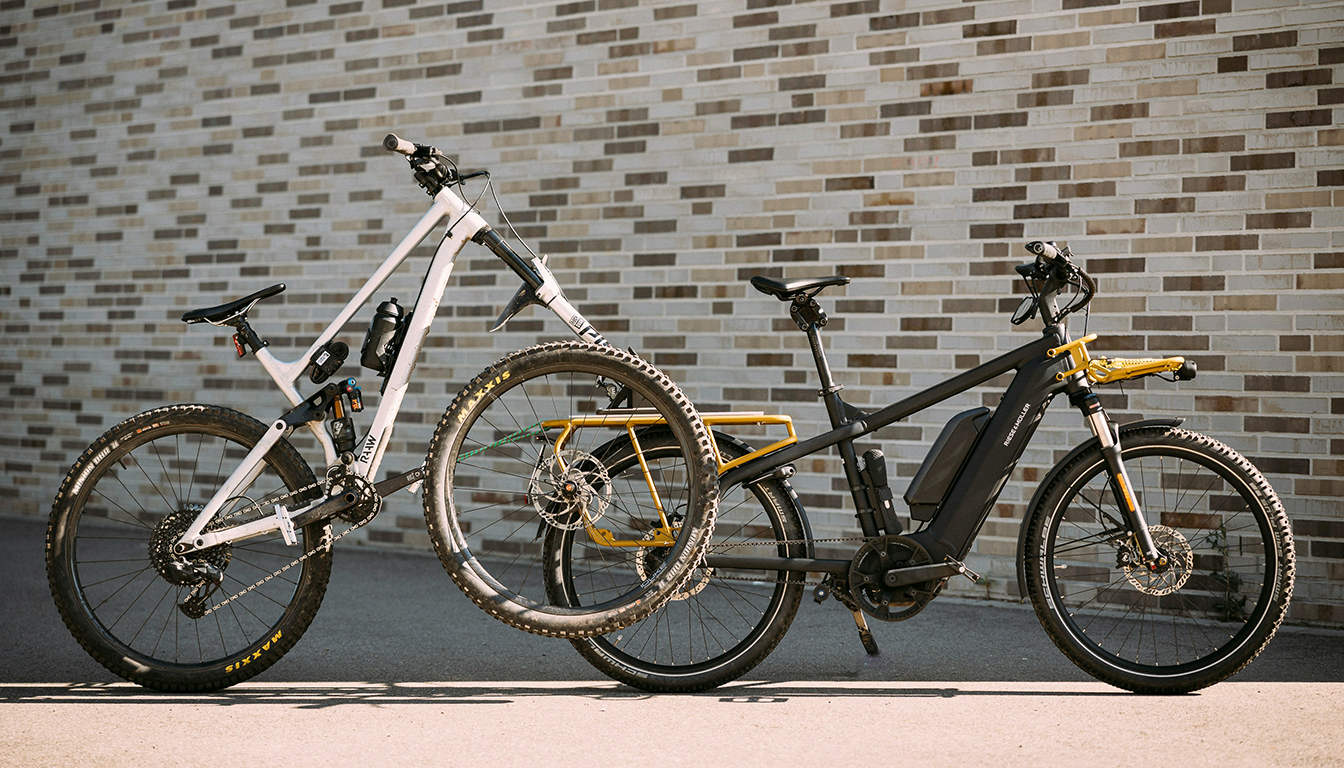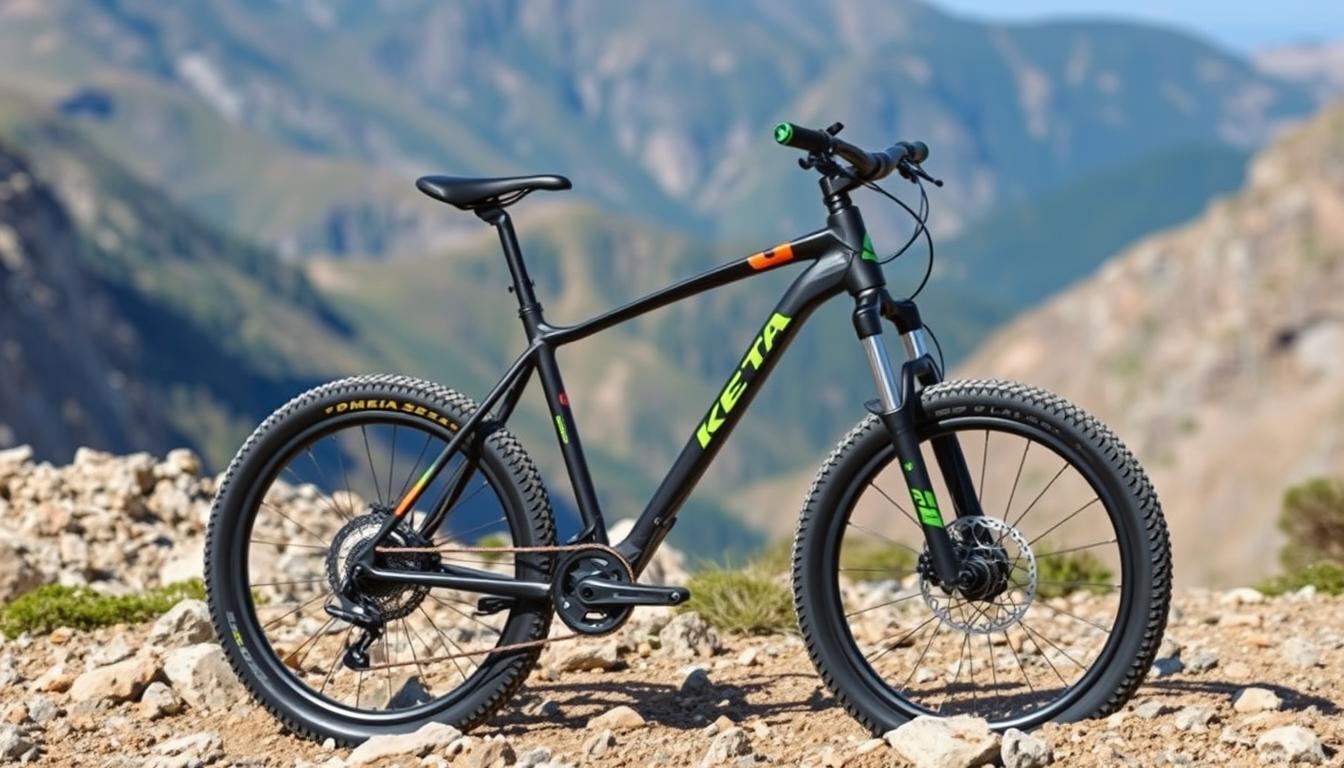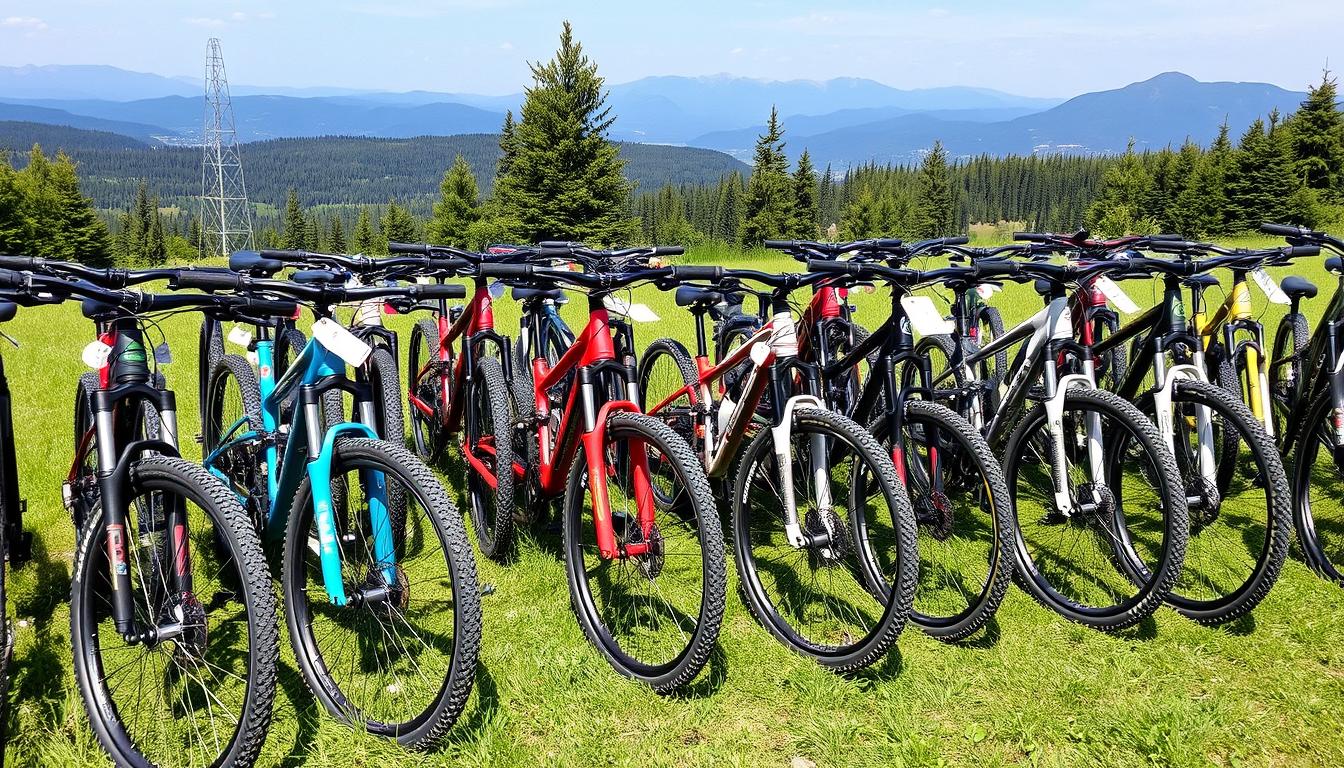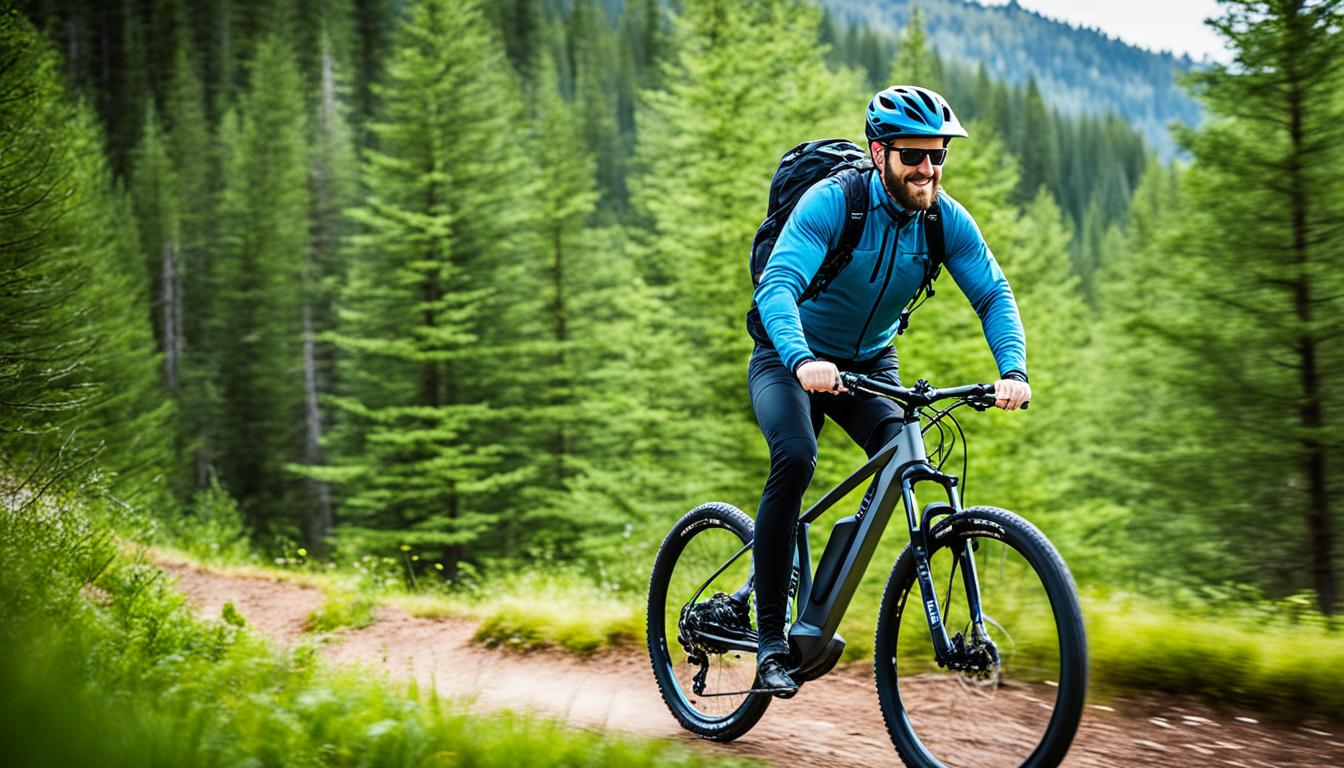The world of mountain bike technology races ahead as 2024 nears. New advancements are set to boost experiences for riders at every level. These include better materials, bike designs, and tech for tackling tough trails.
Electric mountain bikes (E-MTBs) are getting more fans, thanks to pedal help for climbing hills. Also, innovations like smart suspension and top-notch brakes increase safety and fun during rides.
We’re excited to share more about 2024’s mountain bike tech trends. We’ll look at how these features aim to make riding more enjoyable and effective.
Introduction to Mountain Bike Technology Innovations
The world of mountain biking has changed a lot since the 1970s, giving us a great introduction to mountain biking technology. It started with Joe Breeze, who made designs that are the basis for today’s bikes. Bike lovers wanted better performance, and the industry brought new tech to improve riding in every way.
In the 1980s, bikes got hydraulic disc brakes, changing how we control and stop bikes. By the mid-90s, we saw the first widely used hydraulic brakes, thanks to the Hope C2. It even let riders adjust brake engagement, showing how bike innovations have made riding safer and better.
Then, in the late 1990s, Kind Shock gave us the first dropper post, using office chair ideas to let cyclists adjust their seat height. This continued with Stan’s No Tubes in the 2000s, which introduced a system to prevent tyre punctures. These changes show how mountain biking technology keeps adapting.
More recently, in 2012, SRAM brought out the 1x drivetrain system, making gear selection simpler and more efficient. Each innovation points to a trend of new technologies changing mountain biking for the better. This has created a culture of ongoing improvement and progress.
Looking forward, we can expect even more exciting developments. Engineers are working on electronic parts, high pivot designs, and automatic suspension systems. These are set to define the future of bike innovations.
Key Trends Shaping the 2024 Mountain Biking Landscape
The mountain biking industry is seeing big changes as 2024 approaches. Two key trends are electric mountain bikes becoming more affordable, and new bike designs. These changes aim to improve the biking experience. They make the sport more open to people from all walks of life.
The Rise of Affordable Electric Mountain Bikes
Electric mountain bikes (eMTBs) are becoming a hit because they open up tough trails to more people. Brands like Bulls and KTM are at the forefront with their new models. Bulls has made an 18-kilogram eMTB that highlights a shift towards lighter bikes. On the other hand, KTM’s Scarp Exonic is built for those who crave top-notch performance. These bikes show that being electric doesn’t mean compromising on looks.
There’s a growing demand for these bikes, driven by a desire for sustainability. Companies are turning to eco-friendly methods, like 3D printing, to make bikes that are kinder to the planet. Also, eMTBs come with digital features for tracking and navigation. This tech invites newcomers to try out trails with more confidence.
Advancements in Bike Geometry and Balance
Bike design has come a long way recently. Now, the focus is on creating bikes that feel balanced and stable, no matter the terrain. This new approach gives riders more confidence, especially when going downhill or tackling tough patches. Brands are constantly improving their designs, resulting in bikes that offer a smoother and more thrilling ride.
Gravel bikes are developing in two directions. Some are sleek and fast, perfect for racing. Others are built tough for bikepacking and adventures. This shows that the biking world is really listening to what riders want and need.
With these new bike shapes and the breakthroughs in electric mountain bikes, biking is entering an exciting era. Riders will find that these advancements make biking more enjoyable, easier to get into, and fun for every adventure outdoors.
New Mountain Bike Technology 2024
Mountain biking technology is advancing rapidly, making rides better and performance stronger. Innovations in dropper posts and 1x drivetrains stand out. These technologies make biking simpler and improve bike efficiency significantly.
Ongoing Evolution of Dropper Posts
New dropper posts have changed how riders adjust saddle height while moving. This leads to more confidence downhill and better climbing. Dropper posts now have smoother mechanisms and can adjust automatically. This makes biking feel more controlled and stable.
More riders are choosing adjustable posts, so fixed seatposts are less common in new bikes.
1x Drivetrains: Standardising Simplicity and Efficiency
The shift to 1x drivetrains is gaining popularity among mountain bikers. These drivetrains simplify gears without sacrificing performance. They are lighter, more reliable, and easier to maintain.
Getting rid of the front derailleur and having a wide range of gears helps bikes work better. This lets riders easily handle different terrains. Now, many new mountain bikes come with these systems.
For a deep dive into e-mountainbike comparisons, check out this comprehensive test. It highlights the impact of technologies like dropper posts and 1x drivetrains on biking.
The Impact of Wheel Size Innovations
Mountain biking is evolving quickly, mainly due to wheel size changes. Riders now face a choice between sizes that can boost their ride. The battle is mainly between 29-inch and 27.5-inch wheels. Each brings its own perks, fitting different riders and styles.
29-Inch Wheels vs. 27.5-Inch Options
29-inch wheels are a favourite among many bikers. They’re great at getting over obstacles and keep momentum well. This size shines on cross-country and trail rides. It offers more stability and grip on tough paths. Bikers find their ride smoother and less jumpy on tricky trails.
27.5-inch wheels, however, are perfect for quick moves and tight spots. They’re best for riders who love sharp turns and steep drops. This size balances speed with control, making handling in tricky spots faster. Whether it’s a 29-inch or 27.5-inch wheel depends on your style and where you ride.
The Transition to Tubeless Technology
Tubeless bike technology marks a big step forward. It says goodbye to inner tubes for a sealant that cuts puncture risk. This swap means bikes roll more smoothly and grip better on different terrains.
Riders getting into tubeless need wheels that match. Many new models from top brands are ready for this change. Going tubeless boosts confidence and fun, especially on rough trails.
| Wheel Size | Benefits | Ideal For |
|---|---|---|
| 29-Inch Wheels | Greater stability, better obstacle clearance, improved traction | Cross-country, trail riding |
| 27.5-Inch Wheels | Quicker handling, more manoeuvrability | Technical descents, tight corners |
Braking Technology Advancements
Mountain biking has seen big changes in brakes, especially with hydraulic disc brakes since the 1990s. These improvements have made stopping smoother and safer. Now, riders enjoy a better ride thanks to these advancements.
The Evolution of Hydraulic Disc Brakes
Hydraulic disc brakes began as a way to give riders more control. They stay reliable in any weather, perfect for all sorts of terrain. New materials and designs have made them lighter and more effective.
As these systems get better, they offer finer control and less fade. This means safer, more confident rides down steep paths.
Future Developments in Brake Technology
The future looks exciting for bike brakes, with new tech on the horizon. We can expect automatic braking systems that adjust to both the rider and the conditions. Plus, adding electronic parts could make brakes even quicker and more reliable.
Future changes will aim to make brakes stronger and lighter. This ensures top performance for riders without any downsides.
Predictions for the Future of Mountain Bike Tech
The mountain biking world is buzzing with anticipation. 2024 promises new tech from giants like Shimano and SRAM. These changes will enhance how we ride on all types of paths.
What to Expect from Shimano and SRAM
Watch Shimano and SRAM closely as they lead in bike advancements. 2023 saw SRAM leading with its innovative wireless gear shifts. Shimano, however, is catching up with its powerful e-MTB tech.
Expect the eMTB sector to bring lighter, versatile bikes. Brands are diversifying their e-bike ranges. Shimano might join the wireless game, while SRAM has plans for a universal gear hanger.
Pioneering Developments in Suspension Systems
New suspension tech is on the horizon. Wireless systems will improve performance and cut weight. Enduro bikes are getting stronger forks, a sign of tougher designs.
The 2024 Paris Olympic Games will spark unique bike designs. These will include special colours and custom features. For more on what’s coming, click here.
| Technology Aspect | SRAM Innovations | Shimano Innovations |
|---|---|---|
| Wireless Shifting | XX SL, XX, XO, GX | Eagle Powertrain |
| Brakes | Code, Level Stealth | CUES Levers |
| Drivetrain | Wireless drivetrain developments anticipated | Possible entry into wireless market |
| Suspension | Wireless lockouts gaining traction | Focus on lightweight designs |
| Market Segment | Diverse eMTB options | Expanding the eMTB range |
Conclusion
As we conclude our look at mountain bike technology for 2024, it’s clear these advancements will change how we ride. Trail mountain bikes are coming back in style with lighter and more agile designs. Meanwhile, gravel race bikes are evolving to thrill both racers and adventurers.
This shift, including the move towards all-road bikes, shows a trend towards flexibility and performance. It’s an exciting time in the world of cycling.
Also, there’s been a big focus on better aerodynamics and new tech like Shimano’s XTR Di2 updates. We’re also seeing innovations such as lightweight eBike motors and the use of 3D printing. These changes promise to make the next year an exciting one for mountain biking fans.
It’s vital for riders to keep up with these changes to enhance their biking experience. As bikes and gear get better, responding to what riders want, the world of mountain biking is set for an exciting change. By embracing these new ideas, riders will find their adventures on the trails even more amazing.
FAQ
What are the most significant advancements in mountain bike technology for 2024?
For 2024, big changes in mountain bike tech include better electric bikes, new bike shapes for top handling, better dropper posts, and the growing love for 1x drivetrains. These upgrades make biking more fun and easier to get into.
How are electric mountain bikes changing the sport?
Electric mountain bikes are opening up the sport to more people. Cheaper eMTBs let riders tackle trails easily and with more fun, making mountain biking more welcoming.
What role does bike geometry play in performance?
New bike designs focus on better balance and handling, improving how bikes perform on various terrains. These changes help riders stay in control and enjoy their rides more.
What improvements have been made to dropper posts?
The latest dropper posts fix older issues and add auto features for a better ride. This makes seat height changes quick and easy, letting riders switch styles without stopping.
Why are 1x drivetrains becoming more popular?
1x drivetrains are now common because they’re simple and work well. They’re lighter, more dependable, and easier to look after, making biking more pleasurable.
What are the differences between 29-inch and 27.5-inch wheel sizes?
The choice between 29-inch and 27.5-inch wheels depends on their advantages. 29-inch wheels are great for smoothing out bumps and keeping speed, while 27.5-inch wheels offer better control and quick moves, suiting different types of biking.
How does tubeless technology enhance biking?
Going tubeless means fewer punctures and better ride quality. It allows for softer tyre pressures, improving grip and peace on mixed surfaces. Dropping traditional tubes marks a big leap in bike tech.
What advancements have been made in braking technology?
Brake tech has greatly improved with better hydraulic disc brakes, offering more control and safety. Future brakes may introduce features like auto or electronic systems for even better handling.
What can we expect from leading brands like Shimano and SRAM?
Shimano and SRAM are gearing up for exciting updates. Shimano might polish existing gear tech, while SRAM could push forward with better hanger designs and suspension tech, boosting comfort and control for riders.








